
Greater Queens Podiatry, PLLC
 (718) 229-0222
(718) 229-0222
 (718) 229-0222
(718) 229-0222 In a game against the San Francisco Giants, Padres shortstop Erick Aybar suffered a fracture in his foot. Although he was able to stay in the game, he sat out for the rest of the series due to the injury. It is possible that the shortstop could miss the remainder of the season as a result of the fracture. Shortstop has been one of the least productive positions for the struggling 2017 Padres, but they are expected to look to their minor league system in order to find Aybar’s replacement. Going forward, Dusty Coleman and Allen Cordoba are expected to be frontrunners in terms of manning the shortstop position in Aybar’s absence.
In a game against the San Francisco Giants, Padres shortstop Erick Aybar suffered a fracture in his foot. Although he was able to stay in the game, he sat out for the rest of the series due to the injury. It is possible that the shortstop could miss the remainder of the season as a result of the fracture. Shortstop has been one of the least productive positions for the struggling 2017 Padres, but they are expected to look to their minor league system in order to find Aybar’s replacement. Going forward, Dusty Coleman and Allen Cordoba are expected to be frontrunners in terms of manning the shortstop position in Aybar’s absence.
A broken foot requires immediate medical attention and treatment. If you need your feet checked, contact our podiatrists from Greater Queens Podiatry, PLLC. Our doctors can provide the care you need to keep you pain-free and on your feet.
Broken Foot Causes, Symptoms, and Treatment
A broken foot is caused by one of the bones in the foot typically breaking when bended, crushed, or stretched beyond its natural capabilities. Usually the location of the fracture indicates how the break occurred, whether it was through an object, fall, or any other type of injury.
Common Symptoms of Broken Feet:
Those that suspect they have a broken foot shoot seek urgent medical attention where a medical professional could diagnose the severity.
Treatment for broken bones varies depending on the cause, severity and location. Some will require the use of splints, casts or crutches while others could even involve surgery to repair the broken bones. Personal care includes the use of ice and keeping the foot stabilized and elevated.
If you have any questions please feel free to contact our office located in Bayside, NY. We offer the newest diagnostic and treatment technologies for all your foot and ankle needs.
Read more about Causes, Symptoms, and Treatment for a Broken Foot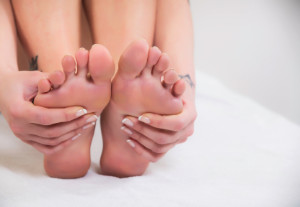 Plantar fasciitis occurs when the tough band of tissue along the base of the foot (plantar fascia) becomes inflamed. The condition itself can be caused by a variety of reasons; the most common being having flat feet, exercising too much, being overweight, or wearing improper footwear. Most people with plantar fasciitis experience pain in the morning that usually goes away as the day progresses. It is a tricky condition to treat because not all cases are the exact same. A treatment that works for one person may not necessarily work for others. However, resting the feet often allows the plantar fasciitis to repair itself over time.
Plantar fasciitis occurs when the tough band of tissue along the base of the foot (plantar fascia) becomes inflamed. The condition itself can be caused by a variety of reasons; the most common being having flat feet, exercising too much, being overweight, or wearing improper footwear. Most people with plantar fasciitis experience pain in the morning that usually goes away as the day progresses. It is a tricky condition to treat because not all cases are the exact same. A treatment that works for one person may not necessarily work for others. However, resting the feet often allows the plantar fasciitis to repair itself over time.
Plantar warts can be very uncomfortable. If you need your feet checked, contact our podiatrists from Greater Queens Podiatry, PLLC. Our doctors will assist you with all of your foot and ankle needs.
About Plantar Warts
Plantar warts are the result of HPV, or human papillomavirus, getting into open wounds on the feet. They are mostly found on the heels or balls of the feet.
While plantar warts are generally harmless, those experiencing excessive pain or those suffering from diabetes or a compromised immune system require immediate medical care. Plantar warts are easily diagnosed, usually through scraping off a bit of rough skin or by getting a biopsy.
Symptoms
Treatment
To help prevent developing plantar warts, avoid walking barefoot over abrasive surfaces that can cause cuts or wounds for HPV to get into. Avoiding direct contact with other warts, as well as not picking or rubbing existing warts, can help prevent the further spread of plantar warts. However, if you think you have developed plantar warts, speak to your podiatrist. He or she can diagnose the warts on your feet and recommend the appropriate treatment options.
If you have any questions please feel free to contact our office located in Bayside, NY. We offer the newest diagnostic and treatment technologies for all your foot and ankle needs.
Read more about Plantar Fasciitis Toenail fungus is a condition that affects approximately 14% of the population. Fungi can be found almost anywhere in our environment, and it is important that you are aware of the different ways you can avoid them. One of the best ways you can prevent toenail fungus is by wearing socks. Some of the best sock fabrics in terms of protecting your feet are nylon, wool, and polypropylene. Another tip is to avoid walking around in wet areas as much as possible, since fungi tend to thrive in moist environments. Anti-fungal powder has also been proven to be beneficial in fighting fungus. The powder works by weakening the cell membrane of the fungus and preventing it from producing ergosterol, an essential part of its structure.
Toenail fungus is a condition that affects approximately 14% of the population. Fungi can be found almost anywhere in our environment, and it is important that you are aware of the different ways you can avoid them. One of the best ways you can prevent toenail fungus is by wearing socks. Some of the best sock fabrics in terms of protecting your feet are nylon, wool, and polypropylene. Another tip is to avoid walking around in wet areas as much as possible, since fungi tend to thrive in moist environments. Anti-fungal powder has also been proven to be beneficial in fighting fungus. The powder works by weakening the cell membrane of the fungus and preventing it from producing ergosterol, an essential part of its structure.
For more information about treatment, contact our podiatrists of Greater Queens Podiatry, PLLC. Our doctors can provide the care you need to keep you pain-free and on your feet.
Toenail Fungus Treatment
Toenail fungus is a condition that affects many people and can be especially hard to get rid of. Fortunately, there are several methods to go about treating and avoiding it.
Antifungals & Deterrence
Oral antifungal medicine has been shown to be effective in many cases. It is important to consult with a podiatrist to determine the proper regiment for you, or potentially explore other options.
Applying foot powder on the feet and shoes helps keep the feet free of moisture and sweat.
Sandals or open toed shoes – Wearing these will allow air movement and help keep feet dry. They also expose your feet to light, which fungus cannot tolerate. Socks with moisture wicking material also help as well.
If you have any questions please feel free to contact our office located in Bayside, NY. We offer the newest diagnostic tools and technology to treat your foot and ankle needs.
Read more about Toenail Fungus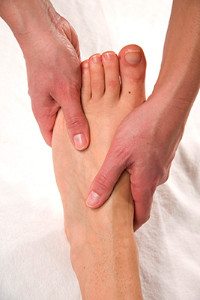 Having healthy feet is important during the summer months when you show them off the most. Although you may be tempted to spend money on a pedicure to pamper your feet, there are ways you can beautify them at home. Soaking your feet in warm water mixed with a few essential oils may help you soften the dead skin and rough calluses you have. If you want to have an antifungal soak, you should add a couple of drops of tea tree oil to the water. It is also important to exfoliate and moisturize your feet so that they feel renewed and fresher than before. If you decide to polish your nails after your at-home pedicure, you should wait approximately ten minutes after painting them before putting on your sandals. This will help ensure that your nails are fully dry and will avoid potentially messing up your new pedicure.
Having healthy feet is important during the summer months when you show them off the most. Although you may be tempted to spend money on a pedicure to pamper your feet, there are ways you can beautify them at home. Soaking your feet in warm water mixed with a few essential oils may help you soften the dead skin and rough calluses you have. If you want to have an antifungal soak, you should add a couple of drops of tea tree oil to the water. It is also important to exfoliate and moisturize your feet so that they feel renewed and fresher than before. If you decide to polish your nails after your at-home pedicure, you should wait approximately ten minutes after painting them before putting on your sandals. This will help ensure that your nails are fully dry and will avoid potentially messing up your new pedicure.
Everyday foot care is very important to prevent infection and other foot ailments. If you need your feet checked, contact our podiatrists from Greater Queens Podiatry, PLLC. Our doctors can provide the care you need to keep you pain-free and on your feet.
Everyday Foot Care
Often, people take care of their bodies, face and hair more so than they do for their feet. But the feet are a very important aspect of our bodies, and one that we should pay more attention to. Without our feet, we would not be able to perform most daily tasks.
It is best to check your feet regularly to make sure there are no new bruises or cuts that you may not have noticed before. For dry feet, moisturizer can easily be a remedy and can be applied as often as necessary to the affected areas. Wearing shoes that fit well can also help you maintain good foot health, as well as making it easier to walk and do daily activities without the stress or pain of ill-fitting shoes, high heels, or even flip flops. Wearing clean socks with closed shoes is important to ensure that sweat and bacteria do not accumulate within the shoe. Clean socks help to prevent Athlete’s foot, fungi problems, bad odors, and can absorb sweat.
If you have any questions please feel free to contact our office located in Bayside, NY. We offer the newest diagnostic and treatment technologies for all your foot and ankle needs.
Read more about Every Day Foot Care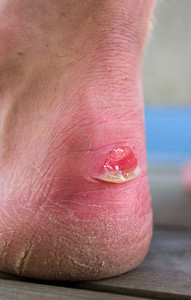 If you are experiencing problems with blisters, it is important that you are aware of how to properly care for them. One of the most important rules of blister care is to not pop it yourself. Another important tip is to avoid wearing the shoes that caused you to get the blister in the first place. Applying an ice pack or a bag of frozen vegetables has been shown to help alleviate some blister-related pain. Typically, blisters heal on their own within a week. Nevertheless, there are cases in which a blister causes its victim more pain than what is normal. If your blister keeps reoccurring in the same area, or becomes infected, you may need to see a podiatrist.
If you are experiencing problems with blisters, it is important that you are aware of how to properly care for them. One of the most important rules of blister care is to not pop it yourself. Another important tip is to avoid wearing the shoes that caused you to get the blister in the first place. Applying an ice pack or a bag of frozen vegetables has been shown to help alleviate some blister-related pain. Typically, blisters heal on their own within a week. Nevertheless, there are cases in which a blister causes its victim more pain than what is normal. If your blister keeps reoccurring in the same area, or becomes infected, you may need to see a podiatrist.
Blisters are prone to making everyday activities extremely uncomfortable. If your feet are hurting, contact our podiatrists of Greater Queens Podiatry, PLLC. Our doctors can provide the care you need to keep you pain-free and on your feet.
Foot Blisters
Foot blisters develop as a result of constantly wearing tight or ill-fitting footwear. This happens due to the constant rubbing from the shoe, which can often lead to pain.
What Are Foot Blisters?
A foot blister is a small fluid-filled pocket that forms on the upper-most layer of the skin. Blisters are filled with clear fluid and can lead to blood drainage or pus if the area becomes infected.
How Do Blisters Form?
Blisters on the feet are often the result of constant friction of skin and material, usually by shoe rubbing. Walking in sandals, boots, or shoes that don’t fit properly for long periods of time can result in a blister. Having consistent foot moisture and humidity can easily lead to blister formation.
Prevention & Treatment
It is important to properly care for the affected area in order to prevent infection and ease the pain. Do not lance the blister and use a Band-Aid to provide pain relief. Also, be sure to keep your feet dry and wear proper fitting shoes. If you see blood or pus in a blister, seek assistance from a podiatrist.
If you have any questions, please feel free to contact our office located in Bayside, NY. We offer the newest diagnostic and treatment technologies for all your foot care needs.
Read more about Blisters on the Feet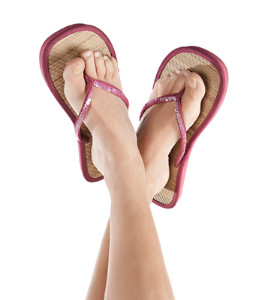 It is no secret that flip-flops can be harmful for your feet. While these noisy shoes may offer a bit more protection for your feet compared to walking barefoot, they do not offer any arch or heel support. Flip-flops can cause small problems such as corns and calluses, or it can cause more serious conditions such as plantar fasciitis. You should also be aware of the fact that flip-flops may cause you to injure yourself by tripping or falling. Flip-flops should only be worn for a short amount of time and are not meant for long-term use. However, if you opt to wear them you should look for a pair that are high quality and made out of leather. The leather material will help prevent blisters and other types of irritation.
It is no secret that flip-flops can be harmful for your feet. While these noisy shoes may offer a bit more protection for your feet compared to walking barefoot, they do not offer any arch or heel support. Flip-flops can cause small problems such as corns and calluses, or it can cause more serious conditions such as plantar fasciitis. You should also be aware of the fact that flip-flops may cause you to injure yourself by tripping or falling. Flip-flops should only be worn for a short amount of time and are not meant for long-term use. However, if you opt to wear them you should look for a pair that are high quality and made out of leather. The leather material will help prevent blisters and other types of irritation.
Flip-flops are not always the best choice of footwear. If you have any concerns about your feet or ankles, contact our podiatrists from Greater Queens Podiatry, PLLC. Our doctors will assist you with all of your foot and ankle needs.
Flip-Flops and Feet
When the weather starts warming up, people enjoy wearing flip-flops. Flip-flops are comfortable, stylish, and easy to slip on and off; they're perfect for any summer beach goer. However, these shoes can cause harm to the feet.
How Can Flip-Flops Affect Me Long-Term?
Are There Injuries Associated with Flip-Flops?
Yes. Since flip-flops are relatively weak and do not provide the same amount of support as sneakers, people who wear flip-flops regularly are more susceptible to injuries. On top of that, the open nature of the shoe makes your feet more prone to other problems, such as cuts and even infections. Common injuries and ailments include:
I like Wearing Flip-Flops. Are There Safe Alternatives?
When buying flip-flops, try to find ones that have sturdy soles and that are made of high-quality materials that will support for your feet. These flip-flops will cost more but will also last longer as a result.
If you have any questions please feel free to contact our office located in Bayside, NY. We offer the newest diagnostic and treatment technologies for all your foot and ankle needs.
Read more about Flip Flops and Feet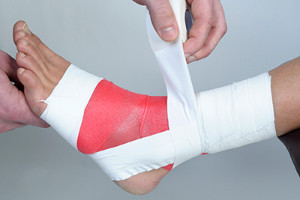 Defensive tackle Kyle Peko of the Denver Broncos suffered a broken foot during practice, which will keep him out of camp for a significant amount of time. He is expected to have surgery on the broken foot soon, which is good news for the Broncos. Although his presence will be missed, Peko is expected to return to the team before training camp ends. Unfortunately the defensive tackle will also be missing important reps during his absence, which is bad news for the rest of the team. Peko’s time out will be an opportunity for younger players to win a spot for a more extended role in the Broncos organization.
Defensive tackle Kyle Peko of the Denver Broncos suffered a broken foot during practice, which will keep him out of camp for a significant amount of time. He is expected to have surgery on the broken foot soon, which is good news for the Broncos. Although his presence will be missed, Peko is expected to return to the team before training camp ends. Unfortunately the defensive tackle will also be missing important reps during his absence, which is bad news for the rest of the team. Peko’s time out will be an opportunity for younger players to win a spot for a more extended role in the Broncos organization.
A broken foot requires immediate medical attention and treatment. If you need your feet checked, contact our podiatrists from Greater Queens Podiatry, PLLC. Our doctors can provide the care you need to keep you pain-free and on your feet.
Broken Foot Causes, Symptoms, and Treatment
A broken foot is caused by one of the bones in the foot typically breaking when bended, crushed, or stretched beyond its natural capabilities. Usually the location of the fracture indicates how the break occurred, whether it was through an object, fall, or any other type of injury.
Common Symptoms of Broken Feet:
Those that suspect they have a broken foot shoot seek urgent medical attention where a medical professional could diagnose the severity.
Treatment for broken bones varies depending on the cause, severity and location. Some will require the use of splints, casts or crutches while others could even involve surgery to repair the broken bones. Personal care includes the use of ice and keeping the foot stabilized and elevated.
If you have any questions please feel free to contact our office located in Bayside, NY. We offer the newest diagnostic and treatment technologies for all your foot and ankle needs.
Read more about Causes, Symptoms, and Treatment for a Broken Foot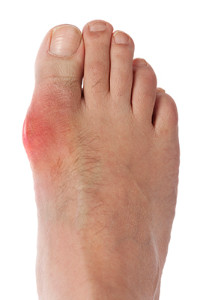 Gout is a form of arthritis, and it occurs as a result of uric acid buildup in the blood. This buildup of uric acid forms needle-like crystals which may cause severe pain in the joints and swelling. Although gout can be managed with proper prescription medications, people who have it should also try to make dietary changes to reduce symptoms. Studies have shown that “men who drink more than two alcoholic drinks a day - especially beer - could increase their chance of getting gout.” Researchers found that the alcoholic content in beer not only impairs the liver’s ability to detoxify uric acid, but it also affects the kidney’s ability to get rid of it. If you struggle with gout, you should consult with your podiatrist to figure out the best ways to prevent an attack in the future.
Gout is a form of arthritis, and it occurs as a result of uric acid buildup in the blood. This buildup of uric acid forms needle-like crystals which may cause severe pain in the joints and swelling. Although gout can be managed with proper prescription medications, people who have it should also try to make dietary changes to reduce symptoms. Studies have shown that “men who drink more than two alcoholic drinks a day - especially beer - could increase their chance of getting gout.” Researchers found that the alcoholic content in beer not only impairs the liver’s ability to detoxify uric acid, but it also affects the kidney’s ability to get rid of it. If you struggle with gout, you should consult with your podiatrist to figure out the best ways to prevent an attack in the future.
Gout is a foot condition that requires certain treatment and care. If you are seeking treatment, contact our podiatrists from Greater Queens Podiatry, PLLC. Our doctors will treat your foot and ankle needs.
What Is Gout?
Gout is a type of arthritis caused by a buildup of uric acid in the bloodstream. It often develops in the foot, especially the big toe area, although it can manifest in other parts of the body as well. Gout can make walking and standing very painful and is especially common in diabetics and the obese.
People typically get gout because of a poor diet. Genetic predisposition is also a factor. The children of parents who have had gout frequently have a chance of developing it themselves.
Gout can easily be identified by redness and inflammation of the big toe and the surrounding areas of the foot. Other symptoms include extreme fatigue, joint pain, and running high fevers. Sometimes corticosteroid drugs can be prescribed to treat gout, but the best way to combat this disease is to get more exercise and eat a better diet.
If you have any questions please feel free to contact our office located in Bayside, NY. We offer the newest diagnostic and treatment technologies for all your foot and ankle needs.
Read more about Everything You Need to Know About Gout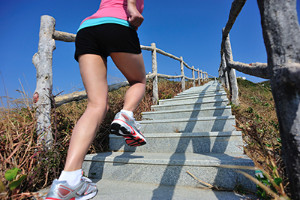 There are certain features that you should ensure your shoes have before you decide to start running. It is crucial that your shoe has arch support, cushioning, and traction in order to improve your running mechanics. The amount of support that you need in your shoe depends greatly on the arch of your foot. For example, people who have feet with high arches do not need shoes with a lot of support, since these may result in injury for them. It is important that you are aware of what type of foot arch you have so that you can find the perfect running shoe for you. Your podiatrist can help you evaluate your foot arch height as well as other factors that will help determine what running shoe you should purchase.
There are certain features that you should ensure your shoes have before you decide to start running. It is crucial that your shoe has arch support, cushioning, and traction in order to improve your running mechanics. The amount of support that you need in your shoe depends greatly on the arch of your foot. For example, people who have feet with high arches do not need shoes with a lot of support, since these may result in injury for them. It is important that you are aware of what type of foot arch you have so that you can find the perfect running shoe for you. Your podiatrist can help you evaluate your foot arch height as well as other factors that will help determine what running shoe you should purchase.
If you are a runner, wearing the right running shoe is essential. For more information, contact our podiatrists from Greater Queens Podiatry, PLLC. Our doctors can provide the care you need to keep you pain-free and on your feet.
Choosing the Right Running Shoe for Your Foot Type
To increase performance and avoid the risk of injury, it is important to choose the right running shoe based on your foot type. The general design of running shoes revolves around pronation, which is how the ankle rolls from outside to inside when the foot strikes the ground.
If you have any questions please feel free to contact our office located in Bayside, NY. We offer the newest diagnostic and treatment technologies for all your foot and ankle needs.
Read more about Choosing the Right Running Shoe for Your Foot Type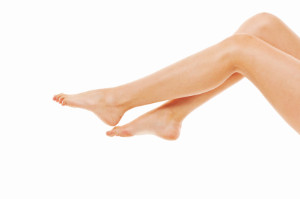 Ingrown toenails occur when the corner or side of the nail grows into the soft flesh. Symptoms may include redness, pain, swelling, and in rare cases, infection. If your ingrown toenail pain is severe or spreading to other places, you may need to see a podiatrist. Your doctor will help give you treatment in order to alleviate the pain you are suffering. People with diabetes and other medical conditions may be at a greater risk of having complications due to ingrown toenails. In order to prevent ingrown toenails, you should always cut your nails straight across instead of in a rounded shape. Another tip is to wear protective footwear such as steel toed shoes. Checking your feet on a daily basis may be helpful in catching an ingrown toenail in its early stage, before it starts to substantially worsen.
Ingrown toenails occur when the corner or side of the nail grows into the soft flesh. Symptoms may include redness, pain, swelling, and in rare cases, infection. If your ingrown toenail pain is severe or spreading to other places, you may need to see a podiatrist. Your doctor will help give you treatment in order to alleviate the pain you are suffering. People with diabetes and other medical conditions may be at a greater risk of having complications due to ingrown toenails. In order to prevent ingrown toenails, you should always cut your nails straight across instead of in a rounded shape. Another tip is to wear protective footwear such as steel toed shoes. Checking your feet on a daily basis may be helpful in catching an ingrown toenail in its early stage, before it starts to substantially worsen.
Ingrown toenails can become painful if they are not treated properly. For more information about ingrown toenails, contact our podiatrists of Greater Queens Podiatry, PLLC. Our doctors can provide the care you need to keep you pain-free and on your feet.
Ingrown Toenails
Ingrown toenails occur when a toenail grows sideways into the bed of the nail, causing pain, swelling, and possibly infection.
Causes
Prevention
Because ingrown toenails are not something found outside of shoe-wearing cultures, going barefoot as often as possible will decrease the likeliness of developing ingrown toenails. Wearing proper fitting shoes and using proper cutting techniques will also help decrease your risk of developing ingrown toenails.
Treatment
Ingrown toenails are a very treatable foot condition. In minor cases, soaking the affected area in salt or antibacterial soaps will not only help with the ingrown nail itself, but also help prevent any infections from occurring. In more severe cases, surgery is an option. In either case, speaking to your podiatrist about this condition will help you get a better understanding of specific treatment options that are right for you.
If you have any questions please feel free to contact our office located in Bayside, NY. We offer the newest diagnostic and treatment technologies for all your foot and ankle needs.
Read more about Ingrown Toenail Care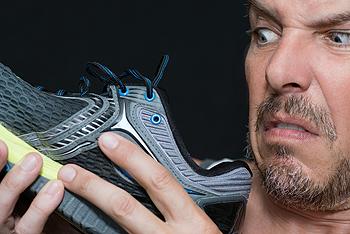 Hyperhidrosis is a disorder that is characterized by excessive sweating beyond what is considered normal. Eccrine glands, or sweat glands, are found at the soles of the feet which is why this condition tends to affect the foot area. People who suffer from hyperhidrosis are often hesitant to reach out for a treatment until their daily routines become affected by the sweat. If the excessive sweating occurs at night, it is important to seek medical assistance as it could be a side effect of a serious medical condition.
Hyperhidrosis is a disorder that is characterized by excessive sweating beyond what is considered normal. Eccrine glands, or sweat glands, are found at the soles of the feet which is why this condition tends to affect the foot area. People who suffer from hyperhidrosis are often hesitant to reach out for a treatment until their daily routines become affected by the sweat. If the excessive sweating occurs at night, it is important to seek medical assistance as it could be a side effect of a serious medical condition.
If you are suffering from hyperhidrosis contact our podiatrists of Greater Queens Podiatry, PLLC. Our doctors can provide the care you need to attend to all of your foot and ankle needs.
Hyperhidrosis of the Feet
Hyperhidrosis is a rare disorder that can cause people to have excessive sweating of their feet. This can usually occur all on its own without rigorous activity involved. People who suffer from hyperhidrosis may also experience sweaty palms.
Although it is said that sweating is a healthy process meant to cool down the body temperature and to maintain a proper internal temperature, hyperhidrosis may prove to be a huge hindrance on a person’s everyday life.
Plantar hyperhidrosis is considered to be the main form of hyperhidrosis. Secondary hyperhidrosis can refer to sweating that occurs in areas other than the feet or hands and armpits. Often this may be a sign of it being related to another medical condition such as menopause, hyperthyroidism and even Parkinson’s disease.
In order to alleviate this condition, it is important to see your doctor so that they may prescribe the necessary medications so that you can begin to live a normal life again. If this is left untreated, it is said that it will persist throughout an individual’s life.
A last resort approach would be surgery, but it is best to speak with your doctor to find out what may be the best treatment for you.
If you have any questions please feel free to contact our office located in Bayside, NY. We offer the newest diagnostic and treatment technologies for all your foot and ankle needs.
Read more about Hyperhidrosis of the Feet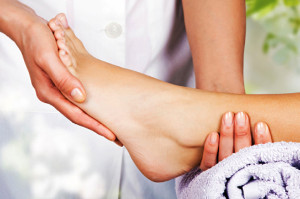 This year Michigan Technological University participated in National Biomechanics Day on April 6th, a world-wide event for educators and students to advance the education of human biomechanics. The Kinesiology and Integrative Physiology Department of the university collaborated with multiple departments across campus and invited local students to participate in hands-on activities focused on biomechanics research. Among these activities, members of the faculty demonstrated various tools used to analyze and describe human motion during exercise. Students were also given the chance to test their strength compared to Michigan Tech football players and to make imprints of their feet, allowing them to analyze how different foot types impact movements across multiple joints.
This year Michigan Technological University participated in National Biomechanics Day on April 6th, a world-wide event for educators and students to advance the education of human biomechanics. The Kinesiology and Integrative Physiology Department of the university collaborated with multiple departments across campus and invited local students to participate in hands-on activities focused on biomechanics research. Among these activities, members of the faculty demonstrated various tools used to analyze and describe human motion during exercise. Students were also given the chance to test their strength compared to Michigan Tech football players and to make imprints of their feet, allowing them to analyze how different foot types impact movements across multiple joints.
If you have any concerns about your feet, contact our podiatrists from Greater Queens Podiatry, PLLC. Our doctors can provide the care you need to keep you pain-free and on your feet.
Biomechanics in Podiatry
Podiatric biomechanics is a particular sector of specialty podiatry with licensed practitioners who are trained to diagnose and treat conditions affecting the foot, ankle and lower leg. Biomechanics deals with the forces that act against the body, causing an interference with the biological structures. It focuses on the movement of the ankle, the foot and the forces that interact with them.
A History of Biomechanics
Modern technological improvements are based on past theories and therapeutic processes that provide a better understanding of podiatric concepts for biomechanics. Computers can provide accurate information about the forces and patterns of the feet and lower legs.
Understanding biomechanics of the feet can help improve and eliminate pain, stopping further stress to the foot.
If you have any questions please feel free to contact our office located in Bayside, NY. We offer the newest diagnostic and treatment technologies for all your foot and ankle needs.
Read more about The Importance of Biomechanics in Podiatry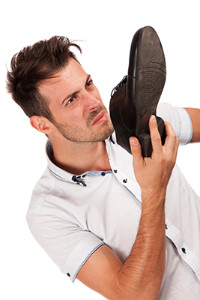 Athlete’s foot is a condition that many people may encounter at some point in their lives. While severe cases of the condition should be referred to a podiatrist, athlete’s foot prevention can be easy with the help of a few simple steps: Wash the feet thoroughly with soap and water, keep the feet clean and dry, wear clean socks and shoes, change shoes and socks often, practice good hygiene, wear sandals or slippers at a public shower or pool, use antifungal powder when needed, and wear shoes that are well-ventilated. Hygiene is key in preventing athlete’s foot and if practiced regularly, should keep the condition at bay.
Athlete’s foot is a condition that many people may encounter at some point in their lives. While severe cases of the condition should be referred to a podiatrist, athlete’s foot prevention can be easy with the help of a few simple steps: Wash the feet thoroughly with soap and water, keep the feet clean and dry, wear clean socks and shoes, change shoes and socks often, practice good hygiene, wear sandals or slippers at a public shower or pool, use antifungal powder when needed, and wear shoes that are well-ventilated. Hygiene is key in preventing athlete’s foot and if practiced regularly, should keep the condition at bay.
Athlete’s foot is an inconvenient condition that can be easily reduced with the proper treatment. If you have any concerns about your feet and ankles, contact our podiatrists from Greater Queens Podiatry, PLLC. Our doctors will treat your foot and ankle needs.
Athlete’s Foot: The Sole Story
Athlete's foot, also known as tinea pedis, can be an extremely contagious foot infection. It is commonly contracted in public changing areas and bathrooms, dormitory style living quarters, around locker rooms and public swimming pools, or anywhere your feet often come into contact with other people.
Solutions to Combat Athlete’s Foot
Athlete’s foot can cause many irritating symptoms such as dry and flaking skin, itching, and redness. Some more severe symptoms can include bleeding and cracked skin, intense itching and burning, and even pain when walking. In the worst cases, Athlete’s foot can cause blistering as well. Speak to your podiatrist for a better understanding of the different causes of Athlete’s foot, as well as help in determining which treatment options are best for you.
If you have any questions please feel free to contact our office located in Bayside, NY. We offer the newest diagnostic and treatment technologies for all your foot and ankle needs.
Read more about Athlete's Foot Those who enjoy hiking as a regular activity should be sure to employ foot care while on the trail to avoid potential pain and injury. The first step to maintaining proper foot care while hiking is to be aware of one’s surroundings. Many hiking-related foot injuries and conditions often occur as a result of not being aware while on the trail: rolled ankles, broken toes, and blisters. When hiking, be sure to wear shoes that are breathable and that either dry quickly or are waterproof. When trying on hiking boots or shoes, finding a great fit is important. With modern innovations in footwear, hiking boots are becoming lighter and more comfortable.
Those who enjoy hiking as a regular activity should be sure to employ foot care while on the trail to avoid potential pain and injury. The first step to maintaining proper foot care while hiking is to be aware of one’s surroundings. Many hiking-related foot injuries and conditions often occur as a result of not being aware while on the trail: rolled ankles, broken toes, and blisters. When hiking, be sure to wear shoes that are breathable and that either dry quickly or are waterproof. When trying on hiking boots or shoes, finding a great fit is important. With modern innovations in footwear, hiking boots are becoming lighter and more comfortable.
Everyday foot care is very important to prevent infection and other foot ailments. If you need your feet checked, contact our podiatrists from Greater Queens Podiatry, PLLC. Our doctors can provide the care you need to keep you pain-free and on your feet.
Everyday Foot Care
Often, people take care of their bodies, face and hair more so than they do for their feet. But the feet are a very important aspect of our bodies, and one that we should pay more attention to. Without our feet, we would not be able to perform most daily tasks.
It is best to check your feet regularly to make sure there are no new bruises or cuts that you may not have noticed before. For dry feet, moisturizer can easily be a remedy and can be applied as often as necessary to the affected areas. Wearing shoes that fit well can also help you maintain good foot health, as well as making it easier to walk and do daily activities without the stress or pain of ill-fitting shoes, high heels, or even flip flops. Wearing clean socks with closed shoes is important to ensure that sweat and bacteria do not accumulate within the shoe. Clean socks help to prevent Athlete’s foot, fungi problems, bad odors, and can absorb sweat.
If you have any questions please feel free to contact our office located in Bayside, NY. We offer the newest diagnostic and treatment technologies for all your foot and ankle needs.
Read more about Every Day Foot Care| Bayside Office 4401 Francis Lewis Blvd Suite L3B Bayside, NY 11361 Phone: (718) 229-0222 Fax: (718) 717-0275 | Monday: 9:30am - 7pm |
E-mail us with any questions